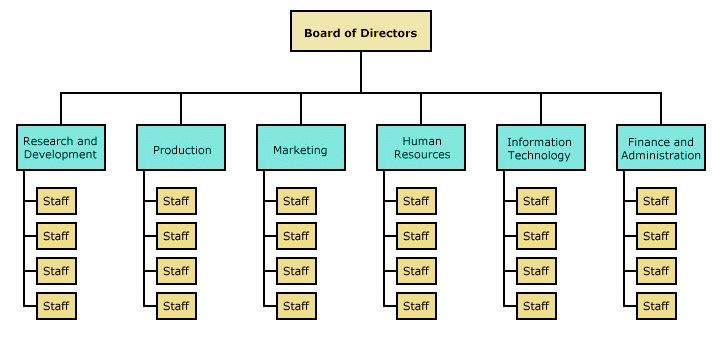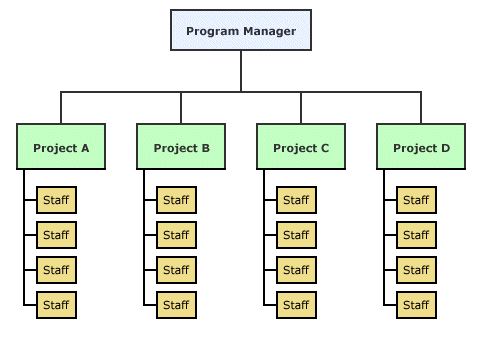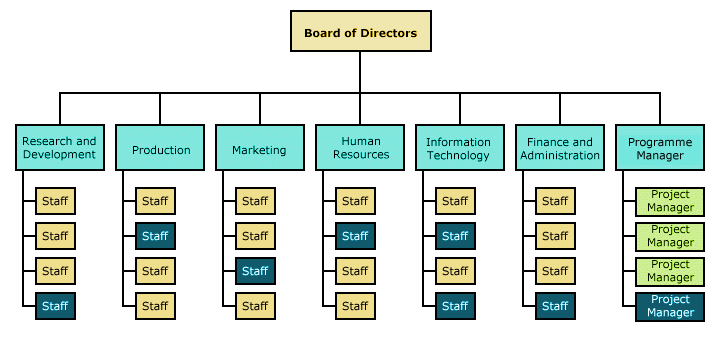Organisational Issues
Organisations of any size have a structure that reflects the kind of business activities in which the organisation is involved, and the way in which the various groups within the organisation relate to each other. The interrelationships and the roles played by each group or individual within the organisational structure are usually documented in an organisational chart. The organisational structure is important to a project in that it forms part of the wider environment within which the project team will function, and will to a large extent influence the way in which the project team will interact with the organisation. Organisational structures tend to be categorised in a number of ways. We will be looking at three examples here, starting with the functional organisation.
The functional organisation has a more or less traditional structure based on organising people and resources according to functional areas. People and groups within a specific functional area carry out similar tasks and share common skills and knowledge. Projects that are carried out within a functional organisation tend to be oriented towards a particular functional area, will often be managed by a senior manager within that functional area, and will have a project team consisting mainly of personnel from that functional area. Where projects involve a number of different functional areas, the question arises as to who will have overall responsibility for the project, and how project resources and personnel will be allocated.

A typical functional organisational structure
The benefits to projects of operating within the environment of a functional organisation include the availability of staff with specialist knowledge in a number of areas, while at the same time being able to focus the main efforts of the project towards a single functional area. It is also an opportunity for staff from different functional areas to collaborate on work that they would otherwise not be involved in, and to take back what they have learned to their own areas. The down side is that there is often a conflict of interest between the responsibilities a team member has towards the project and their normal duties, particularly if they are expected to carry out their normal duties whilst on secondment to the project team.
There may also be issues when it comes to selecting a project manager, particularly if the project directly involves two functional areas that are major stakeholders. If the project involves creating a new information system for the human resources department, for example, both IT and HR will have a major input into the project. Will the chosen project manager therefore be a senior manager from IT who understands the requirements from an IT point of view, or one from HR who understands the functional requirements of his own area far better? The solution to the problem may lie in ensuring that wherever potential conflicts may arise, the project priorities are unambiguously determined in advance. Even so, arbitration may be required from time to time to enable conflict of interest to be resolved.
Some organisations, particularly those whose business involves contract work, organise themselves around ongoing projects, of which there could be any number ongoing at any given time. Each project is managed more or less independently as a separate business unit within the organisation. The project manager is responsible for managing the project work and allocating resources, while overall financial control resides with the program manager. Usually, both the project manager and the project team are committed to the project on a full time basis. This eliminates the kind of conflict of interest that can arise in functional organisations, since the project manager will have a clear and unambiguous mandate, and the project team will be fully committed to the project. Lines of communication tend to be shorter resulting in more effective communication, and there are no competing demands for dedicated project resources.

The project organisational structure
Disadvantages to this approach include the fact that some functional areas are duplicated across multiple projects, while project team members have fewer opportunities to share experiences and good practice with members of other project teams. Some flexibility in allocating personnel and resources is also lost, with personnel in specialised roles being assigned to one project team for the duration of the project even though there may be phases during which their services are not actually required, potentially increasing individual project costs. Project managers are often reluctant to release specialists to work on other projects, preferring instead to retain their services and forego potential savings.
Some organisations adopt a matrix structure that combines features of both the vertically aligned functional structure and the more horizontally aligned project structure. The matrix structure can provides the benefits of both the functional and project structures, but may also exhibit many of the problems inherent in both types of organisation. It can however allow a more integrated approach to the allocation of staff and other resources, and staff with specialised skills can be assigned to a project either permanently or as the need arises. A major weakness is that each project team member will have more than one line manager raising the possibility of conflicts of interest and divided loyalties. There is a clearer division of managerial responsibilities in the sense that, while functional managers will be responsible for providing staff and other resources for the various projects, the project manager will have sole responsibility for coordinating staff and resources within a project. The diagram below shows the organisational structure for a matrix organisation. The highlighted boxes represent the staffing resources for a single project.

A typical matrix organisational structure
The matrix structure allows skilled staff and other resources to be shared by all projects. It is also quite possible for a member of staff in a particular functional area to be assigned to more than one project, resulting in more efficient use of specialist resources. The highly integrated approach can also improve communications, facilitating the flow of information and speeding up both the resolution of problems and the decision making process. There will however need to be a high level of cooperation between project managers and functional managers in order to avoid or at least resolve conflicts. If conflicts cannot be avoided or resolved, a project may become bogged down due to failure to provide the project team with clear leadership. The matrix organisation really comes into its own where the nature of the projects undertaken by the organisation tends to be cross-functional.
Stakeholders
Project stakeholders are individuals, groups, or organisations that have an effect upon, or that are affected by, the project. A stakeholder is generally identified as someone who has an interest in whether or not the project has a successful outcome. The process of identifying stakeholders is both necessary and enlightening, and will throw up some obvious and some not so obvious candidates. The following list, though not exhaustive, includes most of the usual suspects.
- The project owner - the person, group or organisation who has commissioned the project and will take ownership of the deliverables.
- End users - the individuals who will operate or use the product or service that will result from the completion of the project.
- Senior management - those members of the senior management team within the organisation that will directly or indirectly be involved in overseeing project execution and evaluation the project's outcome.
- The project champion - a prominent figure within the organisation who actively supports the project.
- The project manager - the project manager will lead the project team through the process of carrying out the work required to achieve the project's objectives.
- The project team - the individuals tasked with carrying out the work activities required to achieve the project's objectives.
- Functional managers - the managers of the various functions within the organisation (e.g. Human Resources, Information Technology or Accounting) that will be required to provide resources, or that will have an input to or take output from the project.
- Suppliers - those individuals or organisations external to the organisation that provide materials, equipment and services needed by the project.
- Regulatory bodies - government organisations or standards bodies whose function is to ensure that deliverables are produced in compliance with legal requirements or industry standards.
- The general public - where a project has a high public profile, or where the deliverables will provide goods or services primarily intended for public consumption, a number of special interest or consumer groups could potentially have an interest in, and input to, the project.
